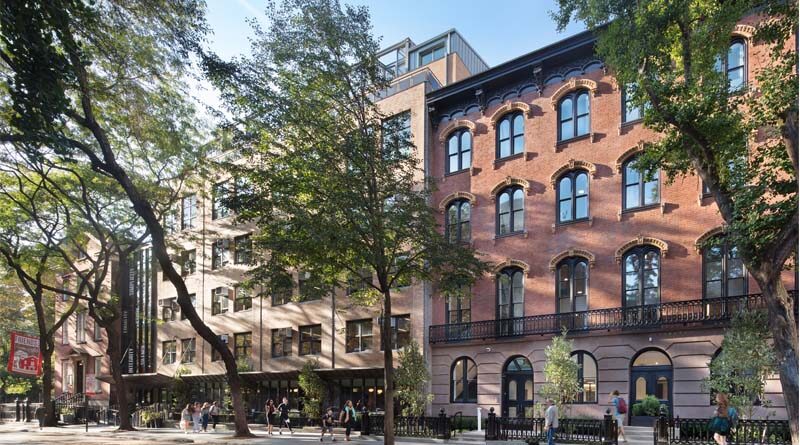Historic New York School Undergoes Major Makeover
By Lisa Kopochinski
NEW YORK CITY—A badly needed renovation and expansion was completed recently to a K-12 school in Manhattan that was built in the mid-1800s.
Friends Seminary has been dealing with the need to expand for decades with an increasing number of students attending classes in the tight space of the 19th and 20th century buildings. At present, there are nearly 800 students at the school, which is located in the Stuyvesant Square Historic District in New York.
The new six-story expansion was constructed behind the facades of three historic townhouses, joining seven buildings around a central court. The campus includes a historic meeting house, a 1963 classroom building, Hunter Hall, and three townhouses constructed in 1852.
Kliment Halsband Architects was the architect on this project and AECOM Tishman served as construction manager. Levien & Company was the Owner’s Representative. The cost of the project has not been disclosed.
The historic townhouse facades have been maintained. Inside, the team excavated new basements, built new floors to align with the floors of the adjoining classroom building, and constructed two new floors of classroom space above the townhouses and classroom building. A narrow skylit gallery separates the new building from the historic facades, and exposed steel bracing bridges between old and new.
The project includes a new accessible entrance and lobby, a Great Room opening directly onto the central court, the Archive Room, a Music suite, Dance and Yoga suite, an Upper School Commons opening onto a rooftop terrace and community space, additional classrooms and offices, study and locker spaces.
The team worked with structural engineer Silman to add a play roof and two classroom floors to Hunter Hall, a four-story building that was built in the early 1960s to create a campus quadrant around a rear courtyard.
“We wanted to minimize demolition inside Hunter Hall, so the structure behind the townhouse facades actually contains most of the lateral support systems for both buildings,” said Silman Senior Project Manager Jim Villano, in a statement.
“But we had to build the addition on top of Hunter Hall first—so we also put temporary lateral braces at the front and back of that building.”
While the façade appears as it did 170 years ago, it conceals a new 29,000-square-foot upper-school wing that, like Hunter Hall, tops out at approximately 70 feet, more than five feet below the maximum height for this landmarked area. It rises to six stories and crowned on the roof with a greenhouse instead of a play space.
For the new upper school of nearly 300 students, Kliment Halsband utilized Collaborative for High Performance School (CHPS) criteria, a national program to improve learning environments as a design standpoint.
The school entrance opens to a terrazzo-clad lobby. Floors are organized around a new stairwell and elevator core at the juncture of the old and new wings. The 30-foot-wide by 63-foot-long columnless space is used for school-wide music, dance, and theater classes. An impact-resistant glass wall on the courtyard opens for indoor/outdoor assemblies and events.
To comply with New York City setback requirements, the additions are virtually invisible at street level. The new structure is approximate five feet behind the historic façade and is supported by a series of vertical trusses in the interstitial space. A sloped skylight at the top transmits daylight down through that narrow volume and adjacent interior spaces.
Said Principal Bo Lauder, “At night, it emits a cheerful glow from within the building.”

